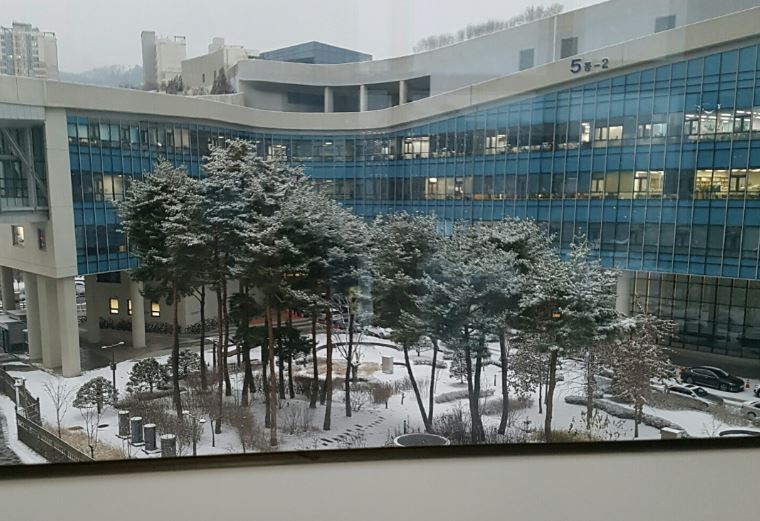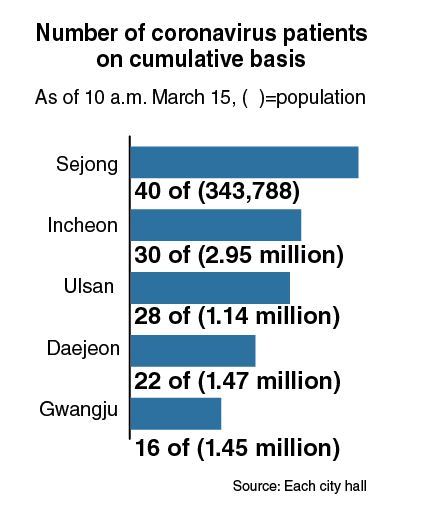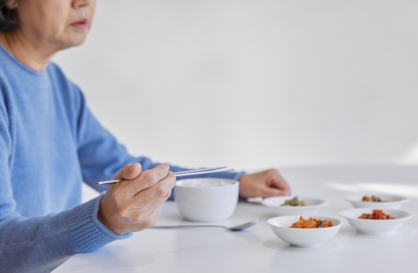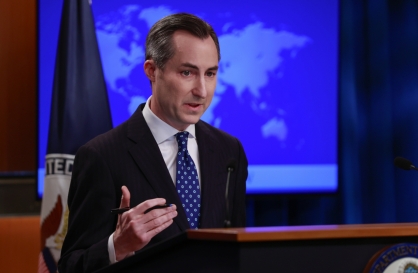 |
Headquarters of the Agriculture Ministry is seen from an air walk passageway at Government Complex Sejong. The bulding, No. 5, is shared by some divisions of the Ministry of Oceans and Fisheries, where the number of COVID-19 infections surged in the second week of March. All the air walks linking 15 buildings in a winding row have been shut down since Saturday. (The Korea Herald) |
SEJONG -- For several weeks until the first week of March, Sejong was posting the smallest number of novel coronavirus infections among 17 major regions in South Korea.
But the nation’s smallest region among the 17, on the basis of population, ranked eighth as of Sunday in the wake of a heap of confirmed cases reported at Government Complex Sejong since March 7.
As of 10 a.m. Sunday, the administrative city saw the number of COVID-19 patients rise to 40, outnumbering tallies in Incheon (30), Daejeon (22), Gwangju (16) and Ulsan (28) -- these are four of the nation’s six metropolitan cities, alongside Busan and Daegu.
Sejong comprises 24 administrative districts -- 14 dongs (neighborhood), nine myeons (township) and one eup (town) -- and whose area far outstrips that of Gyeonggi Province’s Gimpo, Goyang, Seongnam and Suwon cities.
But a worrisome point is that a dominant proportion of the patients were working in “a particular area (Eojin-dong),” where the government complex is located. Three out of every four infected in the city were civil servants working at the complex.
As the civil servants are residing across the 24 districts or commuting from Daejeon, South and North Chungcheong provinces, Seoul and Gyeonggi Province, quarantine authorities fear that the complex will be another core detonator for virus spread nationwide.
 |
(Graphic by Kim Sun-young/The Korea Herald) |
Government Complex Sejong in Eojin-dong has 12 ministries and other core state agencies, whose buildings -- from No. 1 to No. 15 -- are connected in a curved row in the shape of a Korean traditional superstitious blue dragon.
Though the hallways or air walks linking buildings have been barricaded amid growing infections in the complex, there is no way to prevent civil servants at different ministries from contacting others in commuter buses, cafeterias, canteens and retail stores around the complex.
Further, quarantine officials have yet to uncover the infection route of the initial round of patients working at the Ministry of Oceans and Fisheries, where infection cases have reached at least 26 (or more when the infected workers residing outside Sejong City is included: as the figure is based on resident registration).
The Oceans-Fisheries Ministry shares offices with two other ministries -- the Ministry of Agriculture, Food and Rural Affairs in No. 5 building and the Ministry of Economy and Finance in No. 4 building.
In addition, the Ocean-Fisheries Ministry is next to the Ministry of Land, Infrastructure and Transport and the Ministry of Environment, whose offices are in building No. 6.
The Ministry of Health and Welfare at building No. 10, where a civil servant was confirmed as being infected on March 7, is next to the Ministry of Patriots and Veterans in building No. 9, where one worker also tested positive last Wednesday.
The Ministry of Education in building No. 14, where an infection was reported, is adjacent to the Ministry of Trade, Industry and Energy in buildings No. 13-12 and the Ministry of Culture, Sports and Tourism in building No. 15.
The Presidential Archives, where one civil servant tested positive for COVID-19 last Tuesday, is also located in Eojin-dong and right east of the ministries-clustered buildings.
Due to insufficient medical services in Sejong, some of the patients have been sent to bigger hospitals in neighboring cities such as Daejeon, Gongju, Cheonan and Cheongju or are staying at home in self-isolation under supervision by the authority.
By generation, those in their 40s and 50s accounted for the majority of the infected in the administrative city.
A resident in the city said that President Moon Jae-in needs to look into the situation by visiting the complex. “I believe (the president) may as well encourage civil servants at the (quarantine control tower) Health-Welfare Ministry and the (virus-hit) Oceans-Fisheries Ministry, or suggesting guidelines for the Education Ministry over resuming school classes -- like via online -- nationwide.”
Moon visited Daegu, where the highest number of virus infections have been reported among the 17 major regions, on Feb. 25 and Osong, North Chungcheong Province, where the Korea Centers for Disease Control & Prevention is headquartered, on March 11.
By Kim Yon-se (
kys@heraldcorp.com)








![[Kim Seong-kon] Democracy and the future of South Korea](http://res.heraldm.com/phpwas/restmb_idxmake.php?idx=644&simg=/content/image/2024/04/16/20240416050802_0.jpg)
